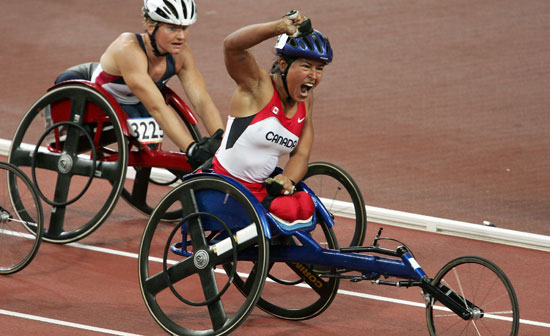Good morning. I am Aimee Mullins, a world record holder and Paralympian in track and field and the president of the Women’s Sports Foundation, a nonprofit national educational organization founded in 1974 by Billie Jean King to advance the lives of girls and women through sports and physical activity. Under my leadership, the Foundation has undertaken as one of its core public policy initiatives to ensure that all girls, including girls with disabilities, have the opportunities to derive the important benefits from sports and physical activity participation.
Ensuring that all students have opportunities for sports and physical activity is especially critical now when we are facing an obesity epidemic among our youth.
- One in every six children is obese (BMI 30+); one in three is overweight (BMI 25+)
- $67.6 billion is spent annually nationwide on health care treatment and research, yet only $17 million is spent each year on prevention. (almost 4,000% more!)
- 300,000 people in the United States die each year from complications related to obesity
- Obesity is the number-one preventable cause of death
- Individuals with disabilities are at an even greater risk of being physically inactive and the subsequent health risks associated with obesity and sedentary behavior.
- 50% of people with disabilities do not engage in any physical activity,
- Only 23% of people with disabilities are active for at least 30 minutes three or more times per week
We know that sports and physical activity is an effective intervention to addressing the obesity epidemic. Especially among individuals with disabilities, the benefits reaped from physical activity are numerous.
Specifically, sports and physical activity participation helps reduce the health care costs spent on treating both direct and indirect costs associated with obesity. Controlling weight and improved circulation prevents health problems, such as reducing the risk of heart disease, breast cancer and debilitating stress-related illnesses such as depression.
Moreover, we know that individuals with disabilities who participate in sports are more confident and have higher self-esteem and better body images than individuals who do not. Furthermore, individuals with disabilities that participate in sports have higher rates of academic success, are more likely to graduate from high school, are more likely to matriculate in college, and experience greater career success and more options.
Despite all these benefits, athletic opportunities for girls and women with disabilities continue to be limited. At present, neither the National Federation of State High School Athletic Associations nor the NCAA officially sanctions any interscholastic or intercollegiate program, event or competition for individuals with disabilities.
When I competed in track and field at Georgetown University, I was the first athlete with a disability to compete against athletes without disabilities as part of an NCAA Division I track team. I was fortunate to compete at a school like Georgetown that embraced my participation on the track team.
However, this type of inclusion is more of the exception than the norm. Not only do most schools not provide teams for individuals with disabilities, but frequently, schools are not willing to allow athletes with disabilities to participate inclusively on teams with athletes without disabilities.
One example of this type of exclusion occurred for Tatyana McFadden, a wheelchair racer in Howard County, Md., who was denied access to compete with her high school teammates on the track at the same time. In Tatyana’s case, it took a lawsuit against the school in order for her to be allowed to race on the track at the same time as the other student athletes.
To prevent situations like Tatyana’s from happening again, the Women’s Sports Foundation joined forces with the Maryland Disability Law Center and passed the Fitness and Athletic Equity for Students with Disabilities Act that signed into law in Maryland in May of this year. This Act is a landmark piece of legislation that, for the first time, specifies the actions school systems must take to include students with disabilities in physical education and athletic programs.
The bill requires that schools ensure that students with disabilities have equal opportunities to participate in physical education and athletic programs, develop policies and procedures to promote and protect the inclusion of students with disabilities, and provide annual reporting to the Maryland State Department of Education detailing their compliance with these requirements.
However, while we have won an important match in Maryland, the set is not yet complete. The lack of opportunities for students with disabilities in school physical activity programs is not isolated to Maryland and thus legislation like the Fitness and Athletic Equity for Students with Disabilities Act is needed nationally.
The Foundation is committed to working to ensure that all of our educational institutions institutionalize the support and infrastructure in their sport and physical activity programs to include students with disabilities.
Sport is too potent a force in society and has too much of an impact on an individual’s health, confidence and self-esteem for us not to do everything we can to ensure that sports girls and boys with disabilities are treated as well as sports girls and boys without disabilities.

